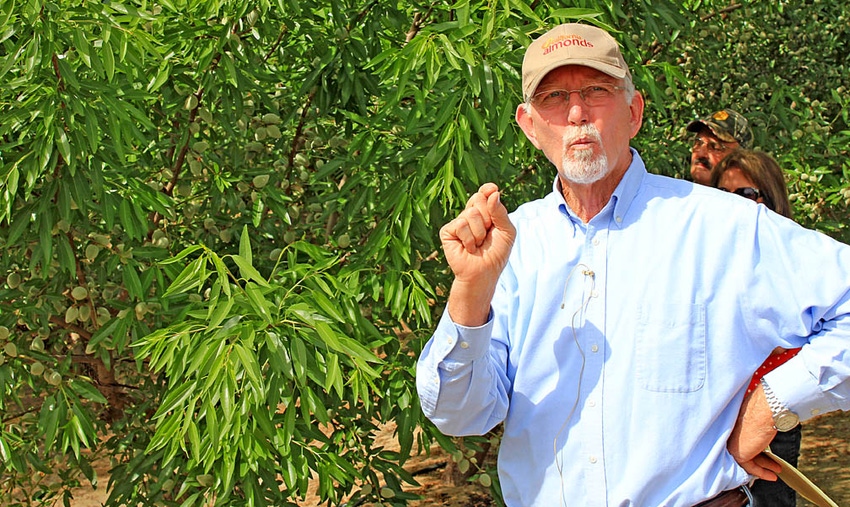April 22, 2014

California’s almond orchards have been thirsty for a while in a drought that threatens to lower yields.
But they are not alone. The bees that pollinate them also found water in short supply this year, according to a beekeeper who spoke at a field day in Fresno on challenges facing growers this year.
The dozens who gathered at the event — including growers, pest control advisors and others — heard strategies for stretching water supplies and ways to keep those bees healthy and active in developing the nut crop with a value in the billions of dollars.
Stress on trees could add fuel to pest problems from critters that include spider mites, said Walt Bentley, emeritus entomologist with the University of California. And, he warned, spraying for other pests such as the Navel Orange Worm could cut down on predators for the mites and cause mite populations to increase.
Videos of presentations at the field day will be posted on the website www.sustainablecotton.org. The San Joaquin Sustainable Farming Project sponsored the event.
Bentley said leaf footed plant bugs can cause damage to almonds with thin husks and pointed out that one grower brought him a tub full of thousands of the pests. He said the Fritz and Sonora varieties are especially vulnerable.
The pest can over-winter in neighboring crops and then migrate into orchards. Bentley said growers or pest control advisors should look for a distinctive thin curlicue, like a little pig tail, on the surface of the nut.
“That’s easier to find than the insect,” he said. Or a broomstick can be used to rap on the tree, causing insects to drop or zoom away. Bentley said May sprays may be in order, but that could trigger a higher mite population. He recommends using a miticide as well.
Particularly vulnerable, he said are orchards near pomegranates or pistachios.
Bentley said the Navel Orange Worm is especially problematic when mummies are left on trees. “They’re the Achilles heel,” he said.
To combat the NOW pest, he said it is important to be sure sprays reach the tops of trees and to drive slowly through the orchard.
“If you’re not driving under 2.5 miles per hour, you’re wasting your money,” chimed in David Doll, UC pomology farm advisor for Merced County.
“I know people hate going slow,” Doll said.
Dropping Speed
He said research showed that dropping the speed from 2.5 miles per hour to 1.8 miles per hour brought a significant improvement in NOW control and a value increase for yields.
Doll said this year’s crop is about two weeks ahead of schedule this year, which could mean an earlier hull split and kernel fill. That has ramifications for water management as the season moves on.
“You may be able to get into and out of the orchards earlier and be hunting in October,” Doll said.
A hot spell the first couple weeks of March could result in smaller nut sizes, he said.
He said tattered leaves on a Padre could be an indicator of shot hole damage. Some Padre nuts are showing “early suture development,” he said. “I don’t know if they will split early, but you need to keep an eye on it,” he said. “You could get some egg laying in that area.”
A willowy branch appearance may be an indicator of a boron or potassium deficiency, Doll said. He recommends a hull analysis and warned against applying boron “if you are importing well water” until you know test results.
Sampling for potassium is best done in mid-July, Doll said.
There’s little doubt that the drought could cut yields. But there are ways to stretch water use to maximize yield, said Gurreet Brar, UC Fresno County farm advisor.
And owners of the orchard where the field day was held say they have no choice. Though the orchard is loaded with nuts at this stage, owners Eric and Gina Rushing know they face a challenge.
As to the need to stretch water, Gina Rushing says, “we have to; we have no choice.”
Brar said regulated deficit irrigation, pioneered in Australia, can work; that it can even improve fruit quality and yield. Still better, he said, rather than cutting irrigation at certain stages, is cutting by a given percentage with each application of water and maintaining uniformity and tuning up irrigation efficiencies while taking into account formulas for evapotranspiration.
Brar warned that cutting back on post-harvest irrigation affects yields in the following year. Across the San Joaquin Valley, there are concerns about lingering drought effects that could cut yields in 2015.
If water to trees is cut at each watering, Brar said, “trees adjust to available water. They are living things that adjust.”
He recommends using pressure bombs to measure water stress.
Honeybee Risk
Gene Brandi with the American Beekeeping Federation talked of the need for most of the nation’s bee colonies – some 1.6 million colonies – to pollinate the almonds in California.
And he warned that there are some beekeepers, notably in the Southern United States who are questioning whether to continue to come to California and risk damage to hives or stay home and make honey that sells for more than $2 per pound.
Brandi and others are concerned that toxicity to bees is not often noted on labels for products that include fungicides and growth regulators.
As for the drought, Brandi said, “this year was tough. There were a lot of places with no water. Bees need some source of clean, uncontaminated water.”
He said 32 beekeepers gathered in Los Banos last month and reported 70,000 colonies negatively affected this year.
Brandi recommends that any spraying during bloom should be done at night, preferably ending by midnight.
The meeting closed with a presentation by Matthew Danielczyk, restoration project manager with Audubon California, on programs to create hedgerows in orchards that can benefit wildlife, provide food for honeybees, combat erosion and mitigate drift.
About the Author(s)
You May Also Like




